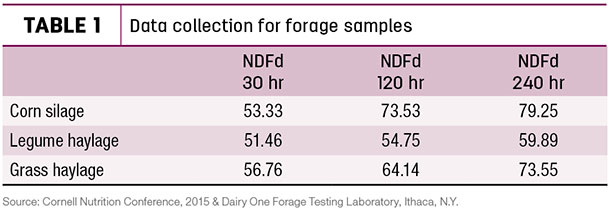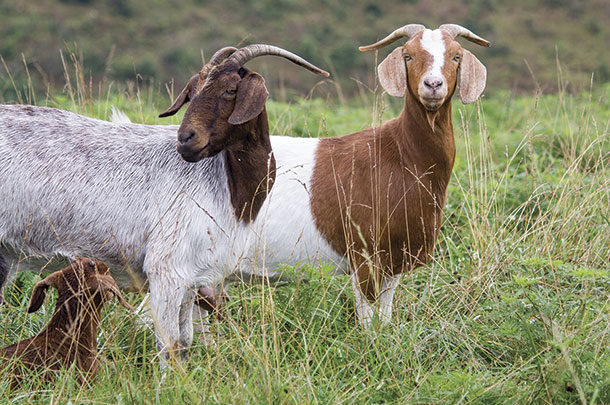These complex carbohydrates, cellulose and hemicellulose, cannot be broken down with just the enzymes and acids found in the simple stomachs of monogastric species such as humans, swine and poultry. The degradation and digestion of the coarse plant material making up leaves, stems and grasses is accomplished by a variety of live microbes consisting primarily of bacteria, protozoa and yeasts.
The ultimate goal of feeding our animals, of course, is to provide nutrition, which enables them to live and be productive. All feedstuffs made available to our animals must provide either energy in the form of calories, or be converted into amino acids that will supply metabolizable protein requirements. Feedstuffs must provide certain levels of vitamins and minerals as well.
Optimal digestion and the nutrition derived from forages are highly dependent upon the quality of those forages consumed by animals. However, quality has many definitions and can often become a subjective matter based upon personal biases and unscientific criteria such as appearance and smell.
Industries such as beef, dairy and equine often have differing requirements for their forage needs. What may be acceptable for a herd of beef cows may not be acceptable for a dairy herd. An equine stable may have different criteria again when choosing forages for proper nutrition and mitigating health challenges.
A fundamental characteristic, and therefore a challenge of forages, is that they are highly variable both physically and chemically – both between species and within species. This results in the uncertainty of their quality and the unpredictability of the digestible nutrients they deliver.
With all areas of animal agriculture becoming increasingly competitive, purchasing a forage or turning animals out on pasture and waiting to see how much milk they produce or how quickly they gain weight is no longer a wise option for a business.
Especially for the dairy industry, moving beyond the static assays of protein, fiber and minerals, researchers and scientists are now focusing on determining how forages ferment and digest in a dairy cow’s rumen. The impetus for this advanced research is driven by the expanding interest in utilizing more forages in milk cow diets as pricing and supplies for grains and commodity byproducts become more volatile.
The assay for neutral detergent fiber (NDF) is currently considered the best test for measuring insoluble fiber and predicting rates of passage for forages. Forages such as grasses and legumes have high percentages of NDF, which is known to depress feed intakes when high enough amounts are included in a diet.
Decreasing feed intakes results in a direct reduction of metabolizable energy and protein. Therefore, laboratory testing has progressed to determining the rates of NDF digestibility for various forages along with the undigestible fraction of the NDF (uNDF) as well.
The ultimate goal for determining the digestibility rates of forage NDF is in quantifying both how much feed or dry matter a cow can consume, along with how much energy can be expected from the fermentation of the various fiber fractions in the forage.
A concept that is gaining acceptance among dairy scientists is that there are at least three pools of fiber digestion – a rapidly digestible pool, a slowly digestible pool and an indigestible pool that is excreted by the cow. These forage fiber pools vary from forage to forage, and the differences will have a profound impact on forage intakes, forage fermentation and ultimately how much milk a cow produces.
Forage laboratories have been testing for different rates of NDF digestibility (24-hour, 30-hour and 48-hour tests), estimating the amount of NDF that would be digested prior to passing from the rumen.
Knowing these values enables nutritionists to estimate the rumen retention of forage, gut fill and how much volatile fatty acids will be produced, allowing for an estimation of energy metabolism and milk production. In addition to the 24-, 30- and 48-hour NDF digestibility, labs have also developed a 120- and 240-hour NDF digestibility that essentially measures the slow and indigestible pools.
Data collected from Dairy One Forage Testing Lab (Ithaca, New York) shows the significant difference of NDF digestibility (NDFd) for the three forage groups (Table 1).

Corn silage, overall, has the highest average NDFd, at almost 80 percent. Total average NDFd for grass haylage is over 73 percent, while total average NDFd for legume haylage was the lowest, at just below 60 percent.
It is noteworthy that for the three species of forages, their NDF digestibility is similar through the first 30 hours. Corn silage and grass NDF continues to disappear beyond that time point. However, the NDF digestibility in legumes declines, creating more gut fill and slowing down digestion.
The differing rates of NDF digestibility for these three forage groups will impact the amount of rumen forage fill and fermentation at any given time. While legume forages have long been prized for their higher protein levels, they appear to have a greater propensity to limit overall energy absorption when fed in higher amounts due to higher levels of undigestible NDF.
For forage growers and dairy farmers, understanding the variability of fiber digestibility in forages is becoming more critical when balancing rations, particularly for high-producing herds. Especially with hay crop forages, NDF digestibility will change from cutting to cutting and field to field throughout the course of a growing season.
To test just one cutting for digestibility and assume that a diet will be in balance all year long based on a single sample is a mistake. The NDFd for corn silage will vary based on hybrid and from field to field, based on growing conditions as well.
The primary purpose of forages should, first and foremost, supply a given level of nutrition to meet a predetermined growth or production requirement. All forages have the potential to provide nutrition to our animals, even if it provides only physical fiber that improves rumination. However, the more fibrous the forage becomes, the less energy it will supply to animals.
Our animals will always tell us if a forage is good or poor based on their performance. But in these days of market volatility, knowing ahead of time the digestibility characteristics of forages will prevent any unwanted surprises that will negatively impact a producer’s revenue. ![]()
PHOTO: Goats and cattle (both ruminants) graze together in the Ozark foothills near Aurora, Missouri. Photo by Lynn Jaynes.

-
John Hibma
- Consulting Ruminant Nutritionist
- South Windsor, Connecticut
- Email John Hibma










